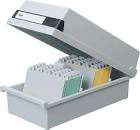Business from data perspective
Introduction
Business Data Management (or: BDM) provides a framework on defining, modelling and documenting your data from business perspective. The focus is on the business itself and the world it operates in. This is a distinct with the data management functions within organisations we already know where the focus is on IT-systems and data stored. The Business Data Model is the result of analysing the business and is not a solution for an IT application.
Because of this focus, a logical consequence is that not the IT department but the business itself is in charge to model their world. As the business should not wait for IT to document their processes for the need of application development, business has the responsibility to document and explain how their world looks like. A Business Data Model is a structured and well documented way to do so.
Business and Accounting
Business experts manage and operate their business environment witin the “real world”. They have their customers of flesh and blood, tangible products or services delivered, distribution centres, physical distribution, etc. This world often is complex and large, activities or the results of it must be shared with other colleagues, departments, companies. Documenting our work is extremely important and accounting systems are used for that purpose. Initially they were manual systems (“books”), already for decades computers are essential for automating business processes and maintaining (parts of) accounting systems (data) electronically.

Within accounting systems data related to and describing the business world are stored and maintained. So any accounting system holds a descriptive model of the real world and will always have its limitations. Secondly, each accounting system is subject of an implementation. For manual systems, like an implementation within a card filing system, for example the physical order of data will result in certain limitations in accessing, linking and using the data.

But also IT systems may have a poor implementation, due to lack of knowledge of the business, change of business over time which the system could not cover, technical limitations, use of standard (bought) software or inability of technical staff to (re)design systems with an improved implementation. Thirdly, systems sometimes only keep track of data that is the end result of a business process, loosing essential business data on initial input of that process and the transformation of the data during the process. See anecdotes on Transaction (click here) and Trades.

For Business Data Management the real world business is subject of investigation, avoiding a blurred vision that may arise from analysing and documenting data held within accounting systems.
In the introduction above we said: “Business Data Management provides a framework on defining, modelling and documenting your data from business perspective”. Now that we distinguish between Business and Accounting we put forward the statement that “Business Data Management provides a framework on defining, modelling and documenting your business from data perspective”.
Goal of Business Data Management
The main goal of Business Data Management is to create one language for each business within an organisation. When different people use different words for the same thing misinterpretations and misunderstandings are the result. Do we do contracts with our customers or agreements? Or do we have clients? Even business itself may think it is the same but do not be surprised if you ask about examples, the one may show 3.2 million contracts and the other 3.6 agreements. And when you think that the first one missed out 400.000 contracts, analysis may show that the two sets have only 2.6 million in common…..
Business Data Management studies all relevant Business terms. So not only terms that will end up as data within an accounting system but also Business terms related to processes and information. Like order value, annual turnover, etc. Even internationally used terms as EBITDA may have a company specific meaning and context. Information related Business terms will all have Business rules on how the values for these terms are constructed by using other Business terms and how they are presented.
Business should speak and write with one language, avoiding homonyms and synonyms. Policies, documents, website, etc. should adhere to that. And of course, semantics of these approved Business terms should be made clear and documented and used for training and other explanation purposes.
Once we have this right, the accounting systems used should talk this language too. In order to prevent any misunderstanding of which business data should be documented where within the system. First at the human interface level of the accounting system to make business and system “talk” the same language. At the data entry but also at the information production side of the human interface, they are all well defined Business terms in order to understand what we write and read. Secondly also the inner world of the system should use the same terminology. Systems support and execute (parts of the) business processes so it must be clear what and how data and software elements support certain business tasks and what data and information they give back.
When we extend the “one language” to the inner world of the accounting systems, Business Data Management touches and gives a framework for regular Data Management that is common in most (larger) companies. Data within the systems should be named according to the business language: according to the Business terms and definitions. For the purpose of clear understanding of the meaning of the data for information processing within the systems and businesses.